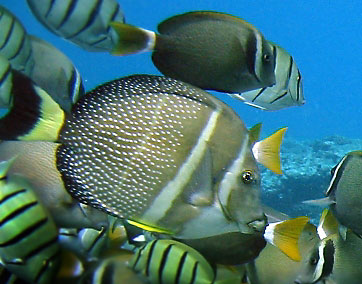
| Sea creature browser: |
 Turtles |
 Triggerfish |
 Tang |
 Surgeonfish |
 Moray eels |
 Butterfly fish |
 Parrotfish |
 Goatfish |
 Jellyfish |
 Urchins |

Surgeonfish
There are over 80 species of surgeonfish worldwide and 25 of these varieties live in Hawaiian waters. Although they come in many different color variations, they all share the same basic structure. The name “surgeonfish” comes from their hard spines at the base of their tail. They have one spine on each side of their body that lies flat in a groove until the fish is provoked. In times of danger, a surgeonfish will flip its tail and the spines pop out like small knives. They resemble a surgeons’ scalpel, thus the name surgeonfish.
Surgeonfish are herbivores and reside in the shallow waters of the coral reef. They feed on algae, so look for them near rocks that get a lot of filtered sunlight. Depending on the variety of surgeonfish, you will find them grazing alone or in small groups. They do not typically form large schools but stick to small groupings.
Surgeonfish Appearance
Surgeonfish can grow to 22 inches, depending on the variety, so they are often among the easiest fish to see in Hanauma Bay. Their size and variety of color make them prominent citizens in the bay’s ecosystem.
The largest surgeonfish in the region are the Yellowfin Surgeonfish. They average at 21 inches and eat almost any type of algae available. They are light tan in color with yellow pectoral fins and yellow markings around the eye. Except for their size, they do not stand out much in the bay because of their light coloring and minimal markings.
The Whitespotted Surgeonfish (in picture) is another resident of the Hanauma Bay region. They can be found grazing on seaweed right where the surf is crashing. They are white and black with two large white stripes toward their head, and white spots covering the remaining two-thirds of their bodies. They have a black and white striped tail. The white spots are part of their camouflage as they resemble bubbling water.
Orangeband surgeonfish are also easily recognizable. They look like they are split in half with a white head and gray tail region. Their midsection starts out grey and ends in a black tail. They have a bright orange band in the white portion of their body placed just behind each eye. These fish swim in schools along the sandy ocean floor and eat the scraps from other fish. They are like the garbage men of the region.
These are just three of the many different varieties of surgeonfish in Hanauma Bay. Taking note of the different types of surgeonfish alone will give you a good idea of what you are looking at when you are snorkeling in the bay.